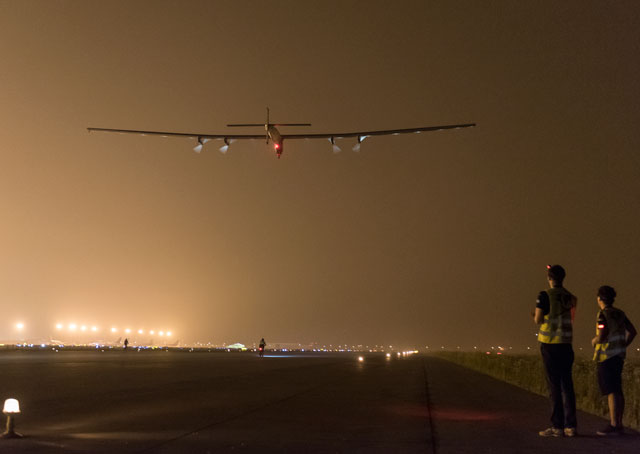
A Pacific Ocean cold front turned back the attempted crossing from China to Hawaii by the fragile Solar Impulse 2, though the team celebrated the longest zero-fuel flight to date even as it scrambled to assemble ground support in Japan.
Pilot André Borschberg endured 44 hours, 10 minutes of flight time in the cramped cockpit, reaching a peak altitude of 28,000 feet after departing Nanjing, China, struggling to find rest amid turbulence (in an aircraft with very little tolerance for turbulence) and circling for many hours over the Sea of Japan as the team watched for a break in the weather.
“Exploring how to sleep in a cockpit that’s building up trust in the behavior of the airplane,” Borschberg said in a social media post that was fed along with live video and commentary through the team website during the flight. “To succeed in this long duration flight we have to partner airplane and pilot. Energy for the airplane and good rest for me.”
As it turned out, good rest would come sooner than Borschberg and the team had hoped—presumably in a bed in Japan rather than the cockpit of the solar aircraft where Borschberg practiced yoga to relax his mind and body. Several cockpit photos were posted as Borschberg flew, none showing a smile, though fellow pilot Bertrand Piccard (who has been flying alternating legs) was visibly enthusiastic in a video interview from mission control, pointing out that Solar Impulse had proved it has the power to fly without fuel forever. The aircraft batteries carried sufficient reserve power to keep the motors turning through the night, and rebuild that reserve during daylight hours.
“That was my dream… and it happened, last night,” Piccard said. “We are so happy, so elated about that I would say it compensates (for) the disappointment that we cannot continue the nonstop flight to Hawaii.”
As Borschberg logged the longest solar flight to date, more than doubling Piccard’s 20 hours and 29 minutes to reach China on March 31, the Solar Impulse team he co-founded with Piccard scrambled to secure permits and clear customs in Japan, orchestrating a welcome at Nagoya-Komaki Airport, where the fragile aircraft would require a temporary hangar large enough for wings that roughly match the span of a Boeing 747, and a large ground crew, many riding bicycles.
“I know the decision to divert to Nagoya has not been easy to take by the Monaco Control Center, because the technical aspect of the flight was going so well. This landing has been made possible by the extraordinary support of all the Japanese Authorities for which Solar Impulse is thankful!” Borschberg said in a news release.
Piccard noted that the decision to make an unscheduled stop in Japan will narrow the routing options as the team waits for another window to give the slow-moving aircraft (Borschberg averaged 35 knots over his 44-hour flight) a chance to reach Hawaii.
Team meteorologists will now look for another five-day window in the weather, one that limits turbulence allowing the pilot to rest, and limits the workload associated with altitude and direction changes at night, when power must be carefully conserved.



